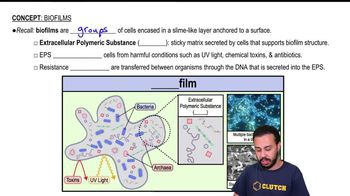Use the following graph to answer questions 3 and 4.
<IMAGE>
Which of the lines best depicts the log phase of Listeria monocytogenes growing in a human?
 Tortora 14th Edition
Tortora 14th Edition Ch. 4 - Functional Anatomy of Prokaryotic and Eukaryotic Cells
Ch. 4 - Functional Anatomy of Prokaryotic and Eukaryotic Cells Problem 6.8a
Problem 6.8a Verified step by step guidance
Verified step by step guidance



Use the following graph to answer questions 3 and 4.
<IMAGE>
Which of the lines best depicts the log phase of Listeria monocytogenes growing in a human?
Assume you inoculated 100 facultatively anaerobic cells onto nutrient agar and incubated the plate aerobically. You then inoculated 100 cells of the same species onto nutrient agar and incubated the second plate anaerobically. After incubation for 24 hours, you should have
a. more colonies on the aerobic plate.
b. more colonies on the anaerobic plate.
c. the same number of colonies on both plates.
A pastry chef accidentally inoculated a cream pie with six S. aureus cells. If S. aureus has a generation time of 60 minutes, how many cells would be in the cream pie after 7 hours?
bacterial culture was in log phase in the following figure. At time , an antibacterial compound was added to the culture. Draw the lines indicating the addition of a bactericidal compound and a bacteriostatic compound. Explain why the viable count does not immediately drop to zero at x. <IMAGE>
The following outline can be used to identify important bacteria. Fill in a representative genus in the space provided.
<IMAGE>
If you Gram-stained the bacteria that live in the human intestine, you would expect to find mostly
a. gram-positive cocci.
b. gram-negative rods.
c. gram-positive, endospore-forming rods.
d. gram-negative, nitrogen-fixing bacteria.
e. all of the above.